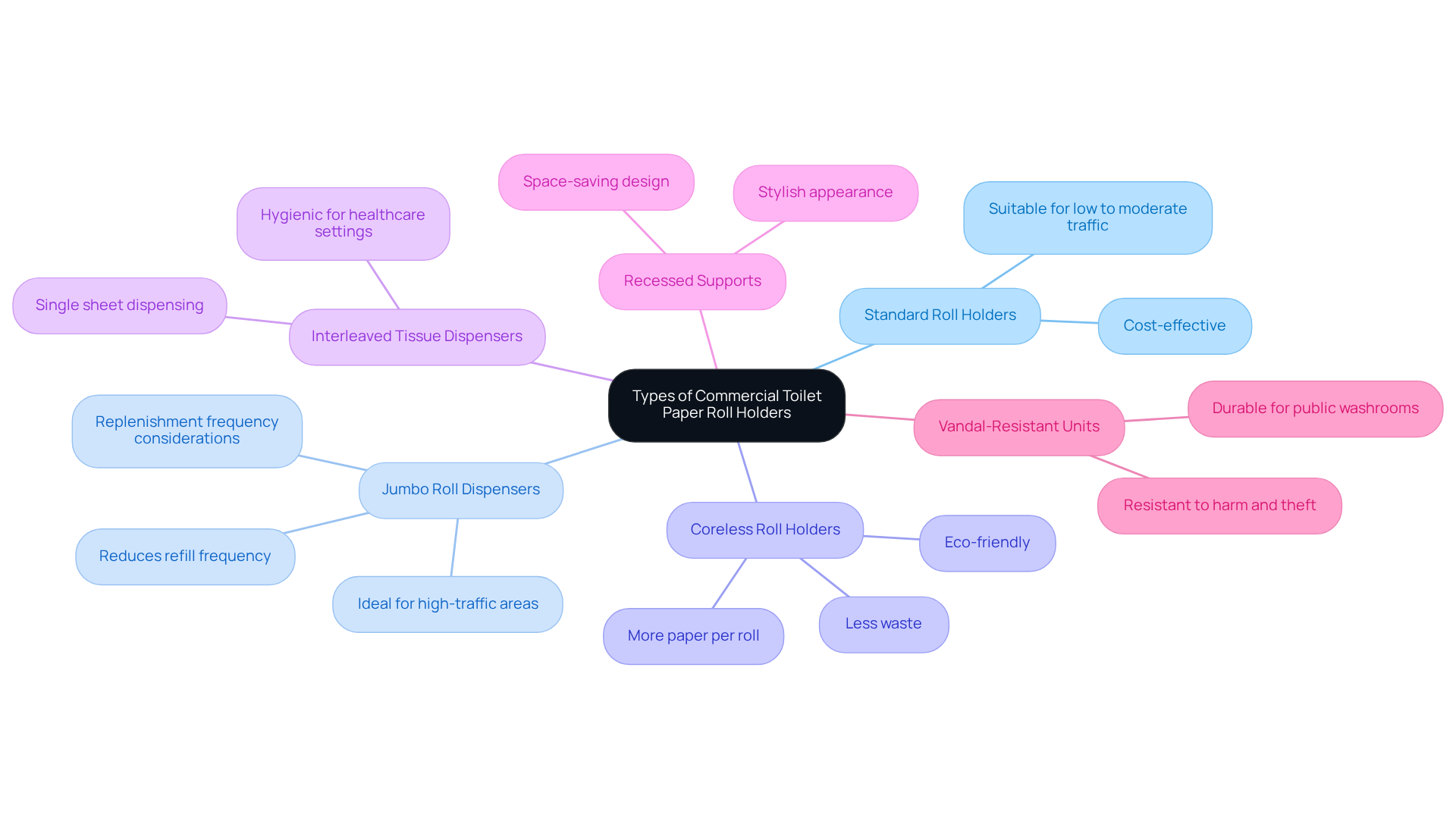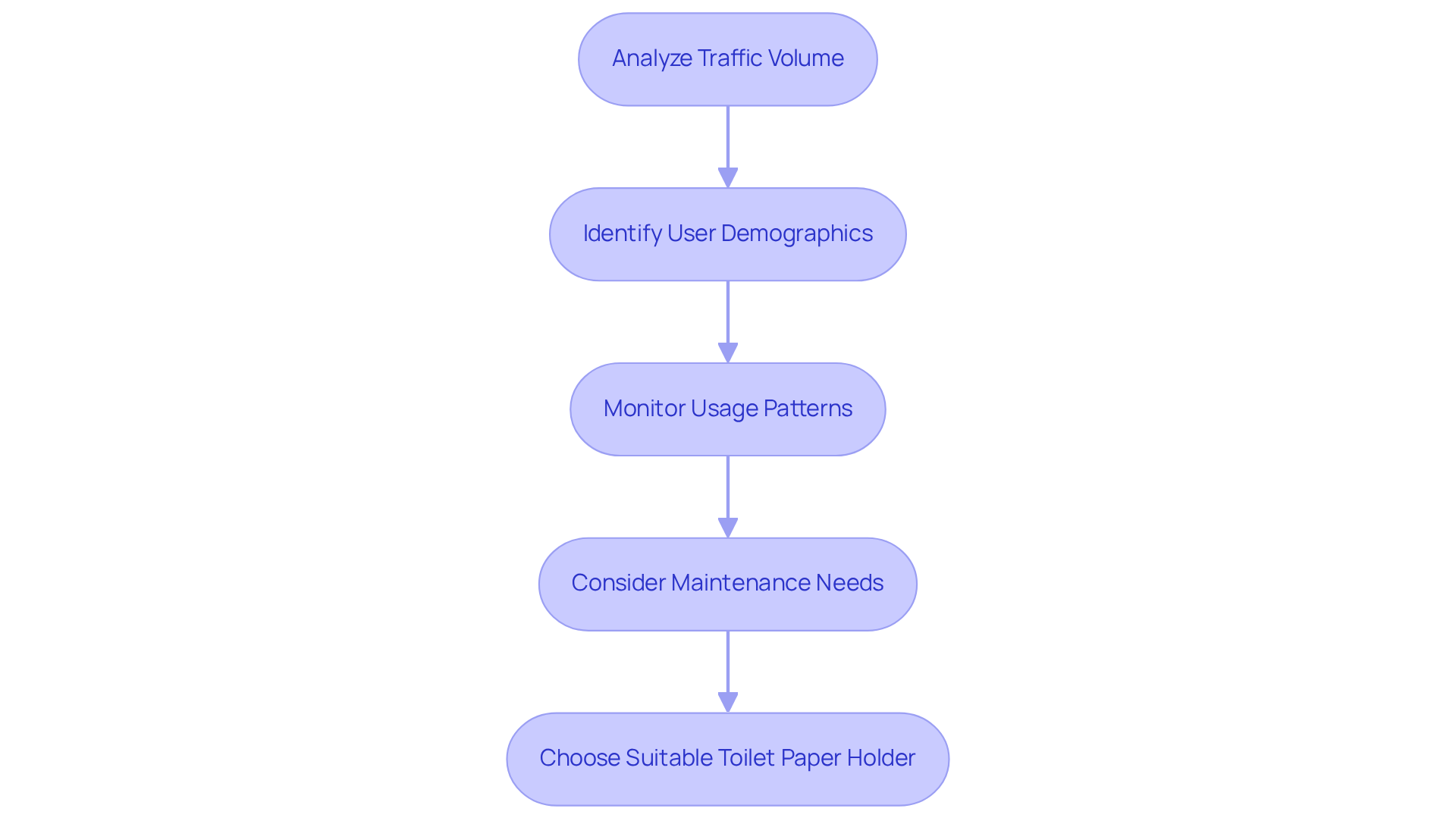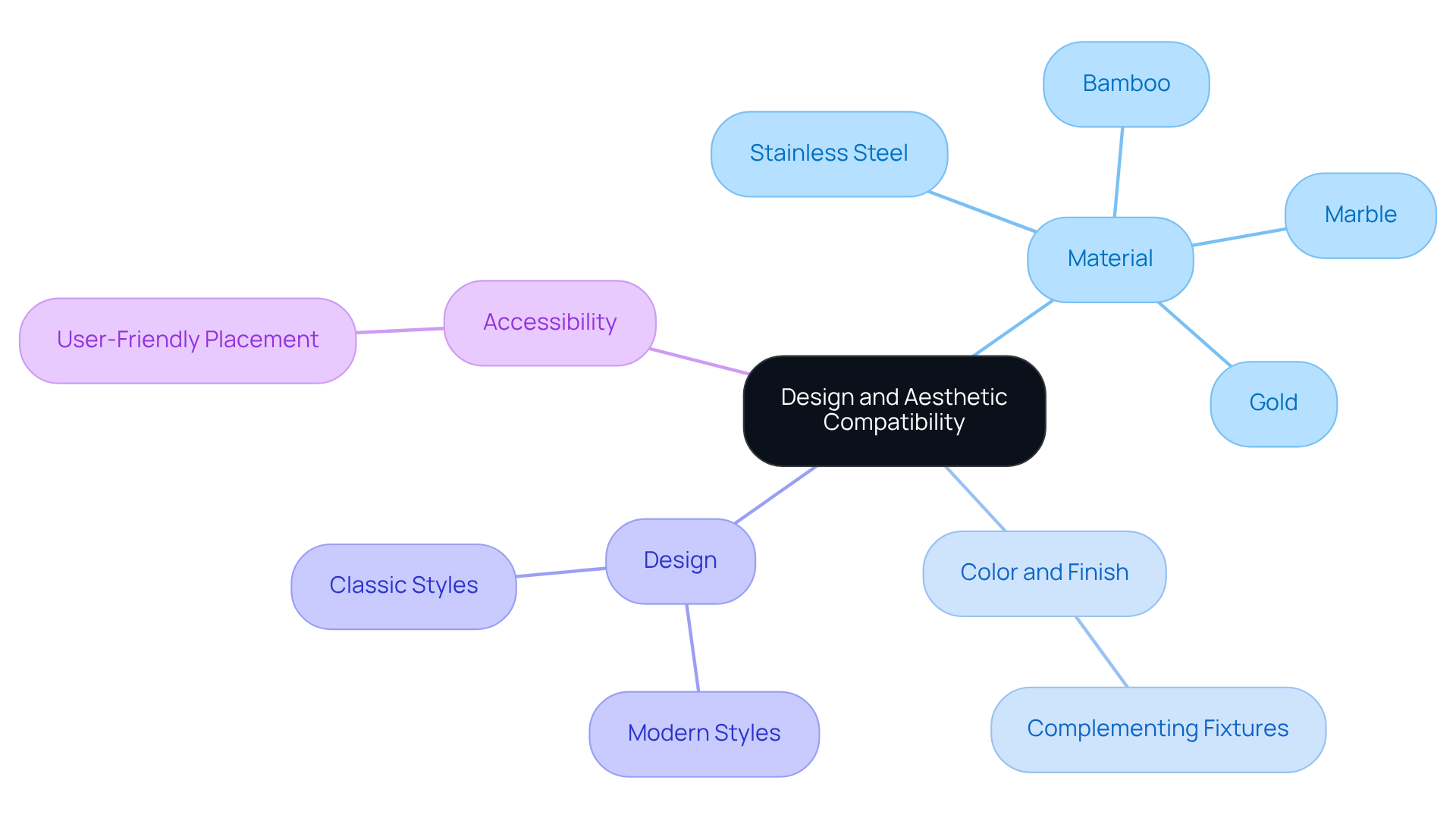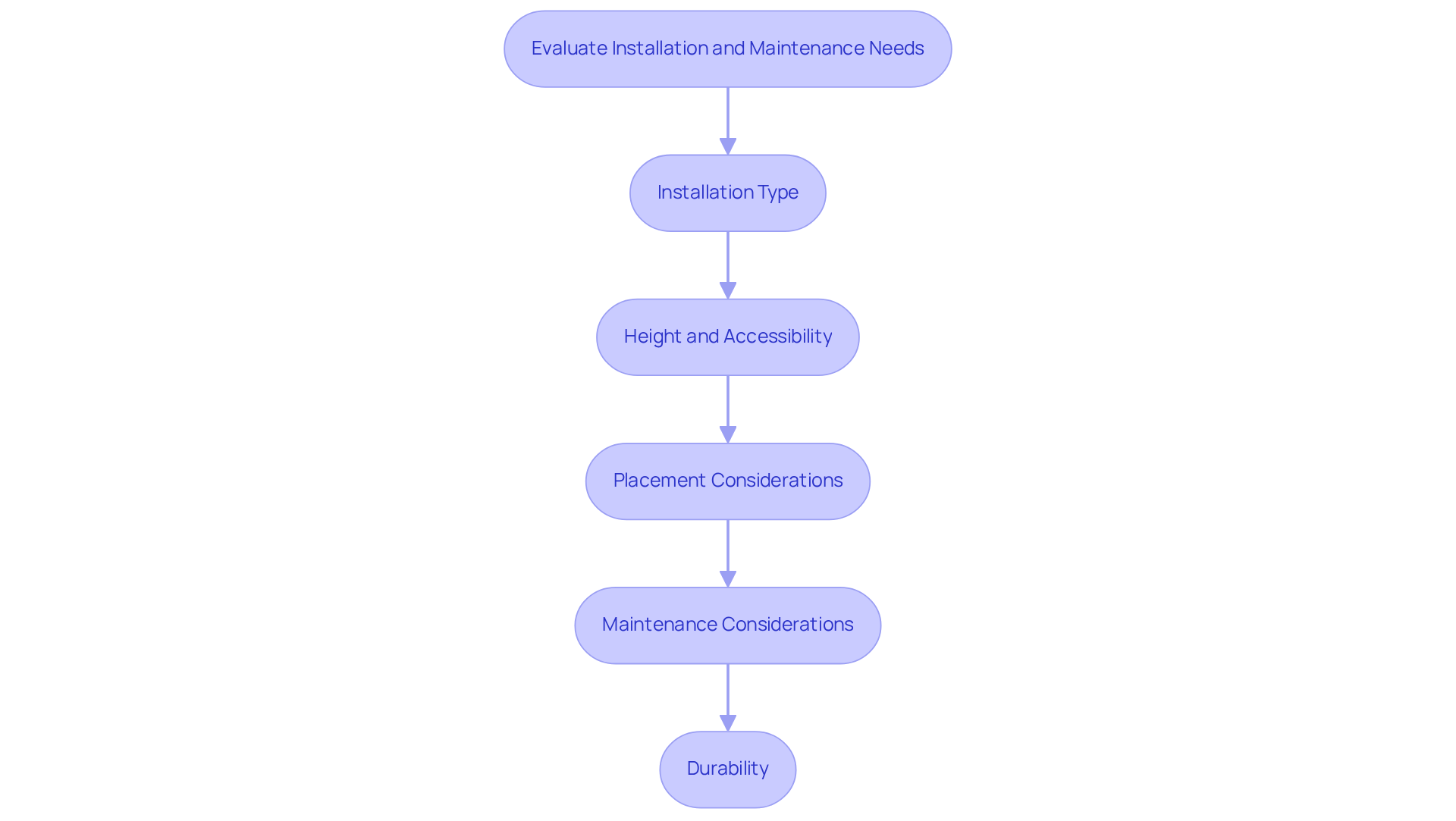Overview
Choosing the right commercial toilet paper roll holder requires a thorough evaluation of the available types, an assessment of restroom traffic and usage patterns, consideration of design compatibility, and planning for installation and maintenance needs. This article meticulously outlines these essential steps, detailing various holder types while emphasizing the significance of user demographics and traffic volume.
Furthermore, it highlights the importance of aesthetics and accessibility, ensuring a well-informed selection process that enhances both functionality and user satisfaction.
Introduction
Selecting the appropriate commercial toilet paper roll holder may appear to be a minor consideration; however, it is pivotal in ensuring restroom efficiency and user satisfaction. With a range of options available—from standard and jumbo roll holders to coreless and vandal-resistant models—facility managers must grasp the specific needs of their establishments.
How can they guarantee the selection of a holder that not only fulfills practical requirements but also elevates the restroom's overall aesthetic? This guide explores the essential steps for making an informed choice, harmonizing functionality, design, and maintenance considerations.
Identify Different Types of Commercial Toilet Paper Roll Holders
Begin by familiarizing yourself with the various types of commercial toilet paper roll holders available, alongside key considerations for their selection:
- Standard Roll Holders: These are the most common type, designed to hold one or two standard rolls. They are simple and cost-effective, making them suitable for low to moderate traffic restrooms.
- Jumbo Roll Dispensers: Ideal for high-traffic areas, these devices accommodate larger rolls that reduce the frequency of refills, rendering them perfect for busy environments. It is essential to estimate how often staff can replenish these dispensers—whether every few hours, daily, or multiple times a week.
- Coreless Roll Holders: These dispensers utilize rolls without a cardboard core, allowing for more paper per roll and less waste. They are often employed in eco-friendly facilities, aligning with sustainability goals.
- Interleaved Tissue Dispensers: Designed for folded toilet paper, these provide a single sheet at a time, which can be more hygienic and suitable for facilities with specific user needs, such as healthcare settings.
- Recessed Supports: Mounted within the wall, these supports conserve space and offer a stylish appearance, making them ideal for contemporary washroom layouts.
- Vandal-Resistant Units: Crafted to endure harm and theft, these units are crucial in public washrooms where durability is a primary concern.
Understanding these categories, along with the market share of various owners and the latest trends in design, enables a more informed evaluation of which commercial toilet paper roll holder will best meet your restroom's requirements. Furthermore, considering the categories of individuals and daily utilization can enhance functionality and satisfaction.

Assess Restroom Traffic and Usage Patterns
To effectively choose the right toilet paper roll holder, follow these essential steps:
-
Analyze Traffic Volume: Begin by observing the number of individuals in the facility during peak hours. High-traffic locations, such as airports or shopping centers, typically see an average of 200 to 300 visitors each day. These environments necessitate a commercial toilet paper roll holder that can accommodate larger rolls or multiple rolls, thereby minimizing the frequency of refills.
-
Identify User Demographics: Understanding the demographics of restroom users is crucial. For example, facilities frequented by families may benefit from dispensers designed for ease of use by children, while those catering to business professionals might prioritize sleek, modern designs that align with corporate aesthetics. Facility managers often emphasize that recognizing these demographics can significantly influence the selection of dispensers.
-
Monitor Usage Patterns: It is imperative to keep track of how often the toilet paper is used and the rate at which it runs out. In high-traffic locations, such as stadiums or concert venues, the demand for a commercial toilet paper roll holder can be considerably greater, necessitating dispensers with increased capacity. This data will assist in determining the required capacity of the container to ensure continuous availability.
-
Consider maintenance needs: High-traffic zones may require a commercial toilet paper roll holder that is easy to replenish and maintain, thereby reducing downtime and enhancing customer satisfaction. Facility managers frequently highlight the importance of selecting dispensers that minimize maintenance efforts while maximizing convenience for users.
By evaluating these aspects, you can confidently choose a support system that meets the requirements of your restroom setting, ensuring both practicality and user satisfaction.

Consider Design and Aesthetic Compatibility
When selecting a commercial toilet paper roll holder, it is essential to consider various design elements to achieve a cohesive restroom environment.
-
Material: Opt for substances that enhance the overall aesthetic of the bathroom. Stainless steel is often favored for its modern aesthetic and durability, while eco-friendly options like bamboo are increasingly popular due to their renewability and sustainability. Premium materials such as gold and polished marble are also emerging as stylish choices, reflecting a shift towards luxury in bathroom accessories.
-
Color and Finish: The hue and texture of the unit should complement other washroom fixtures, including faucets and sinks. This alignment not only produces a cohesive aesthetic but also enhances the overall arrangement, making the space feel more intentional and thoughtfully curated.
-
Design: The washroom's design significantly impacts the selection of dispensers. For modern styles, smooth and minimalist receptacles are ideal, while classic environments may benefit from more decorative alternatives. The movement towards customized and visually appealing environments underscores the importance of selecting a commercial toilet paper roll holder that complements the bathroom's theme.
-
Accessibility: It is crucial to ensure that the layout accommodates all users, including those with disabilities. Choose a commercial toilet paper roll holder that is placed at suitable heights and is simple to use, thereby encouraging inclusivity in lavatory arrangements.
Brent Otsuka, Manager of Interior Design at Fentress Architects, emphasizes the significance of quality in bathroom layout, stating, "The Splash Lab has well-crafted and beautifully created products." He notes, "I always go to them first to create a holistically designed bathroom." This underscores how The Splash Lab's dedication to quality craftsmanship directly supports the considerations outlined above. By carefully matching the design of the support with the bathroom's aesthetics, you not only improve functionality but also foster a more welcoming and user-friendly environment. As consumer preferences evolve, the demand for stylish and functional restroom accessories continues to grow, making these considerations increasingly relevant.

Evaluate Installation and Maintenance Needs
To ensure a successful installation and ongoing maintenance of your toilet paper roll holder, it is crucial to consider the following steps:
-
Installation Type: First, determine whether the holder will be wall-mounted, recessed, or freestanding. Each type presents distinct installation requirements that can significantly influence the overall restroom layout.
-
Height and Accessibility: Adhering to ADA guidelines for installation height is essential to guarantee access for everyone. The maximum height for a toilet paper dispenser should not exceed 36 inches (91.4 cm) from the finished floor, while a minimum height of 19 inches (48.3 cm) is recommended for accessible bathrooms. Furthermore, the suggested standard height for installing a toilet paper dispenser is approximately 26 inches (66 cm) from the floor, which is comfortable for most adults.
-
Placement Considerations: Position the toilet paper dispenser ideally 8 to 12 inches from the front of the toilet bowl to minimize reaching and twisting, thereby ensuring user convenience.
-
Maintenance Considerations: Opt for containers that facilitate simple refilling and cleaning. Features such as a front-loading design or a lockable mechanism can enhance hygiene and deter theft, making them particularly suitable for high-traffic areas. It is also vital to ensure secure mounting using appropriate wall anchors to prevent wobbling and enhance durability.
-
Durability: Select containers constructed from sturdy materials capable of withstanding regular usage and cleaning. This consideration is especially critical in crowded facilities where wear and tear are prevalent.
By carefully evaluating these factors, you can ensure that the toilet paper roll holder is not only straightforward to install but also practical for long-term use, ultimately enhancing the overall restroom experience.

Conclusion
Selecting the appropriate commercial toilet paper roll holder is essential for optimizing restroom functionality and enhancing user experience. Understanding the various types available, assessing restroom traffic and usage patterns, considering design compatibility, and evaluating installation and maintenance needs enable facility managers to make informed decisions that elevate both practicality and aesthetics.
Key insights underscore the importance of choosing the right type of holder based on:
- Traffic volume
- User demographics
- Maintenance requirements
Furthermore, aligning the design with the overall restroom aesthetic not only improves visual appeal but also fosters a welcoming environment. Attention to installation guidelines ensures accessibility and convenience for all users.
Ultimately, the choice of a commercial toilet paper roll holder transcends mere functionality; it reflects a commitment to user satisfaction and operational efficiency. By prioritizing these considerations, facilities can create a restroom experience that meets the diverse needs of users while maintaining a stylish and cohesive environment.
Frequently Asked Questions
What are the different types of commercial toilet paper roll holders?
The different types include Standard Roll Holders, Jumbo Roll Dispensers, Coreless Roll Holders, Interleaved Tissue Dispensers, Recessed Supports, and Vandal-Resistant Units.
What are Standard Roll Holders?
Standard Roll Holders are the most common type, designed to hold one or two standard rolls. They are simple, cost-effective, and suitable for low to moderate traffic restrooms.
When should Jumbo Roll Dispensers be used?
Jumbo Roll Dispensers are ideal for high-traffic areas as they accommodate larger rolls, reducing the frequency of refills, making them perfect for busy environments.
What are the benefits of Coreless Roll Holders?
Coreless Roll Holders utilize rolls without a cardboard core, allowing for more paper per roll and less waste, making them suitable for eco-friendly facilities.
What is the purpose of Interleaved Tissue Dispensers?
Interleaved Tissue Dispensers provide a single sheet of folded toilet paper at a time, which can be more hygienic and is suitable for facilities with specific user needs, such as healthcare settings.
What are Recessed Supports and where are they used?
Recessed Supports are mounted within the wall to conserve space and offer a stylish appearance, making them ideal for contemporary washroom layouts.
Why are Vandal-Resistant Units important?
Vandal-Resistant Units are crafted to endure harm and theft, making them crucial in public washrooms where durability is a primary concern.
How can understanding these categories help in selecting a toilet paper roll holder?
Understanding the categories and market trends enables a more informed evaluation of which commercial toilet paper roll holder will best meet the restroom's requirements, enhancing functionality and user satisfaction.




